Setting up a fly fishing rod might seem daunting at first, but it’s a straightforward process with the right guidance. Fly fishing offers a unique way to connect with nature and experience the thrill of the catch. At flyermedia.net, we break down the process, ensuring you choose the right gear and master the setup. With the right rod selection and proper line rigging, you’ll be ready to cast like a pro.
1. Understanding the Essentials of Fly Fishing Rod Setup
To properly set up a fly fishing rod, you need the correct rod, reel, line, backing, leader, tippet, and fly. Selecting the right materials for each component is key to success.
1.1 Selecting the Right Fly Fishing Rod
Your fly fishing rod is the foundation of your setup. When choosing a rod, consider its length and weight, which are crucial for casting and controlling the line.
1.1.1 Determining Fly Fishing Rod Length
Rod length largely depends on the size of the waters you’ll be fishing. For larger rivers, a 10-12 foot rod is ideal, while smaller streams are better suited for 7-9 foot rods.
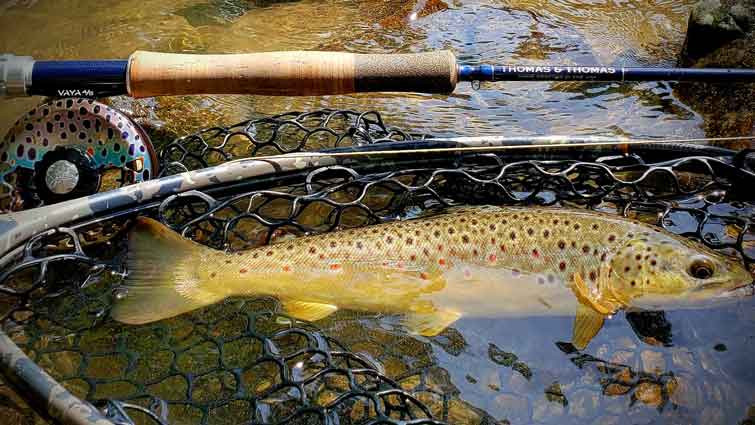 Nymphing fly fishing rod with net
Nymphing fly fishing rod with net
1.1.2 Choosing Fly Fishing Rod Weight
The weight of your rod affects your casting control. Select a rod that feels comfortable and is appropriate for the type of water you’ll be fishing.
| Rod Size (Weight) | Type of Fish |
|---|---|
| 3-4 | Small trout |
| 5 | Average trout/ Typical fly fishing |
| 6-7 | Bass/ Streamer fishing |
| 8-9 | Bass, Pike, Large Trout |
| 10-12 | Tarpon |
1.2 Assembling Your Fly Fishing Rod: Step-by-Step
Assembling your rod correctly is the first step to a successful fly fishing experience. Follow these steps to ensure your rod is ready for action.
1.2.1 Connecting the Rod Sections
Start with the butt section of the rod, which you’ll hold in your hand. Insert the end of the butt section into the next largest section, aligning the dots 180 degrees apart, then twist to secure. Repeat this for the remaining sections until the rod is fully assembled.
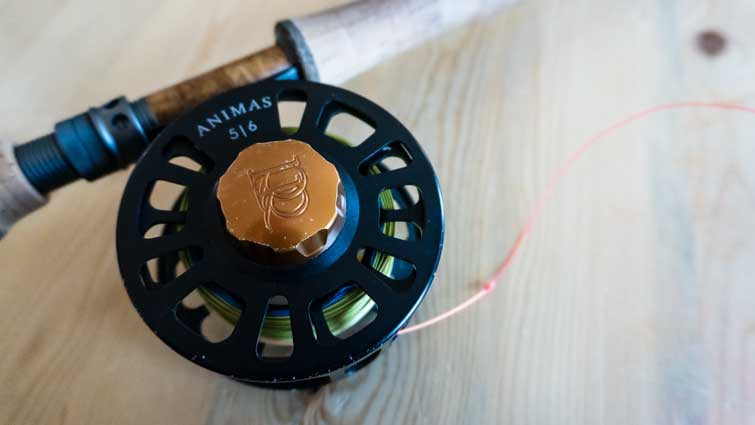 Assembly a fly rod
Assembly a fly rod
1.3 Selecting and Attaching Your Fly Reel
The fly reel is a critical component. Choose a reel that matches the weight of your fly line.
1.3.1 Matching Reel Weight to Your Target Catch
Heavier fly lines require heavier reels, while lighter fly lines work best with lighter reels.
| Reel Size (Weight) | Type of Fish |
|---|---|
| 3-4 | Small trout |
| 5 | Average trout/ Typical fly fishing |
| 6-7 | Bass/ Streamer fishing |
| 8-9 | Bass, Pike, Large Trout |
| 10-12 | Tarpon/ Large saltwater fish |
Your reel should also have a reliable drag system to control fish fighting.
1.3.2 Attaching the Reel to the Rod
Find the cork on the butt section of your assembled rod, unscrew the locking nuts, and slide the reel foot under it so that the reel is in line with the guides. Tighten the locking nuts to secure the reel.
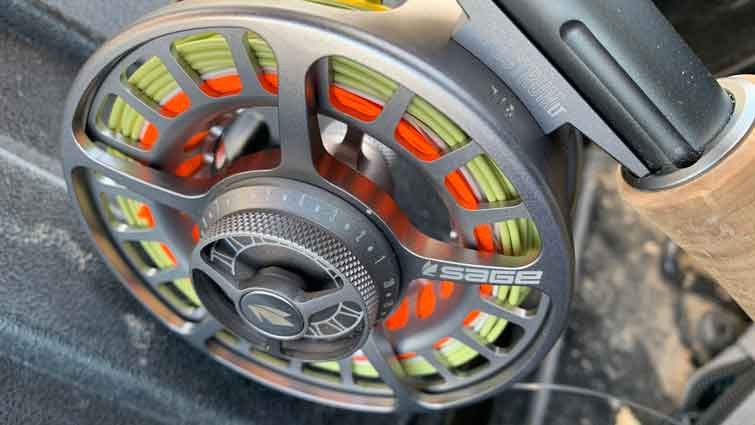 Fly Reel
Fly Reel
1.4 Adding Line Backing: The Foundation of Your Fly Line
Line backing is a braided line that acts as the foundation for your fly line. It provides extra length and strength when fighting larger fish.
1.4.1 Selecting the Right Weight and Amount of Backing
The weight of your line backing should be equal to or greater than the weight of your fly line.
1.4.2 Attaching Backing to the Reel
Use an arbor knot to attach one end of the backing to the spool of your reel and the other to your fly fishing rod.
 Arbor Knot short video click to watch
Arbor Knot short video click to watch
Ensure the reel is correctly configured for either left or right-hand retrieve. Wind 100-200 yards of backing onto the reel, matching the amount to the size of your reel. Check the manufacturer’s website for specific recommendations.
2. Mastering Fly Line Attachment and Types
The fly line is crucial for casting your fly. Understanding the different types and how to attach them is essential.
2.1 Connecting Fly Line to Backing
Use a Surgeons Loop if your Fly Line has a pre-welded loop, or an Albright Knot if it does not, to attach the fly line to the backing.
2.2 Understanding the Main Types of Fly Lines
There are three main types of fly lines, each designed for different fishing conditions: floating, sinking, and sinking tip.
2.2.1 Floating Fly Line
The most versatile type, suitable for most fishing conditions.
2.2.2 Sinking Fly Line
Ideal for fishing in deep water where heavier fish reside.
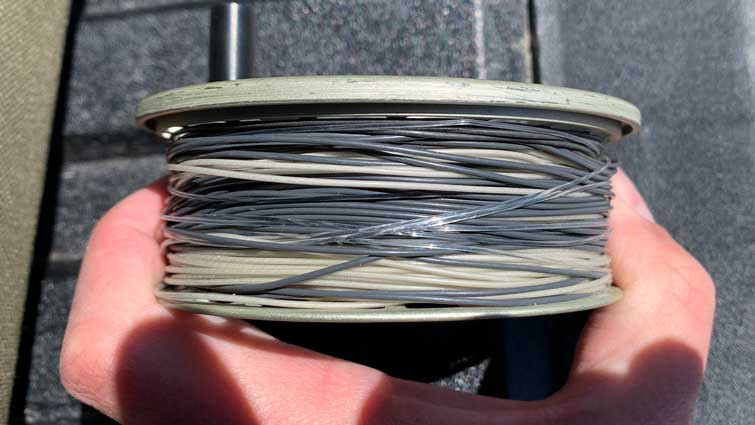 Sinking fly line
Sinking fly line
2.2.3 Sinking Tip Fly Line
A good option for deeper water when you want to maintain a natural-looking presentation. The sinking tip helps get your lure down quickly.
2.3 Choosing the Right Line Weight
Line weight should correspond with your rod and reel and the size of fish you’re targeting.
| Line Weight | Target Fish |
|---|---|
| 1-3 | Small fish and trout |
| 4 | Panfish/ larger trout |
| 5 | Trout/ “all-purpose” |
| 6 | Large Trout/ Bass |
| 7 | Bass/ Salmon/ Steelhead |
| 8 or more | Large saltwater salmon |
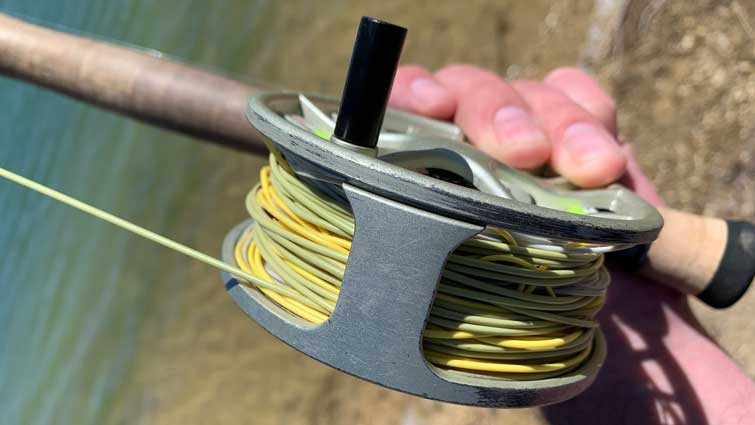 Fly Line on a fly rod
Fly Line on a fly rod
2.4 Ensuring Proper Line Alignment on the Reel
Fly line should come off the bottom of the reel. This ensures there is enough room between the rod handle and the line for your fingers, preventing issues when a fish takes a bite.
3. Connecting the Leader: Enhancing Your Fly Presentation
Leaders are essential for connecting the fly line to the fly. They help present the fly naturally and are typically made of monofilament or fluorocarbon.
3.1 Selecting the Right Leader Material
Monofilament is cheaper but more visible, while fluorocarbon sinks faster and is less visible.
3.2 Attaching the Leader to the Fly Line
Use a loop-to-loop connection or a blood knot to attach the leader to the fly line. A nail knot or snail knot is also effective for larger diameter fly lines and leader materials.
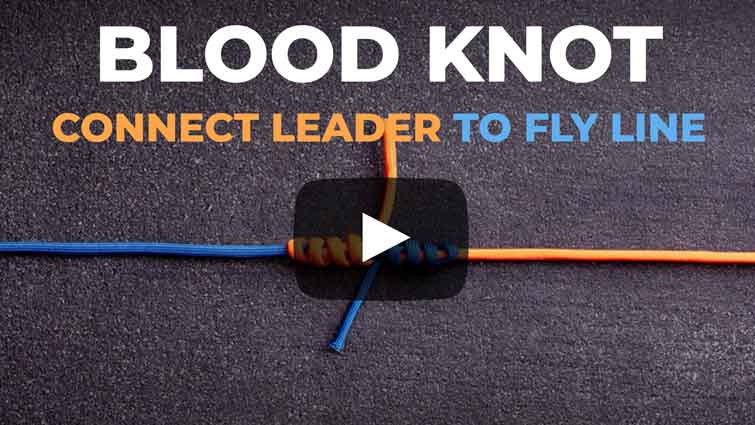 Blood Knot Video – How to Attach Leader to Fly Line
Blood Knot Video – How to Attach Leader to Fly Line
3.3 Determining the Ideal Leader Length
Fly fishing leaders range from 6 to 12 feet. A 9-foot tapered leader is a great starting point. Ensure there is a loop at the end for easy fly line attachment.
3.4 Understanding the Role of Tippet and Leader
Tippet and leader work together to provide a seamless transition from the fly line to the fly, ensuring a natural presentation.
3.4.1 When is Tippet Necessary?
Tippet is not always necessary if you have a long enough tapered leader. It is useful for extending your leader or adding length when your leader gets too short from adding flies.
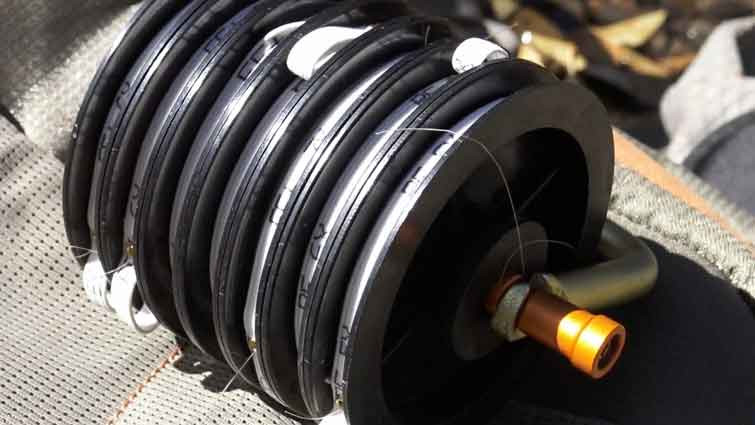 Tippet for fly fishing
Tippet for fly fishing
3.4.2 Functions of Tippet and Leader
The tippet provides a transition between the fly line and the leader, protecting the fly line from abrasion and acting as a shock absorber. The leader helps cast the fly accurately.
4. Connecting the Tippet: Fine-Tuning Your Presentation
The tippet is the final section of the leader, connecting the fly to the hook.
4.1 Choosing the Right Tippet Material
Tippets come in monofilament and fluorocarbon.
4.2 Attaching the Tippet to the Leader
Use a double surgeons knot to attach the tippet to your leader. This knot also allows you to add additional tags for flies.
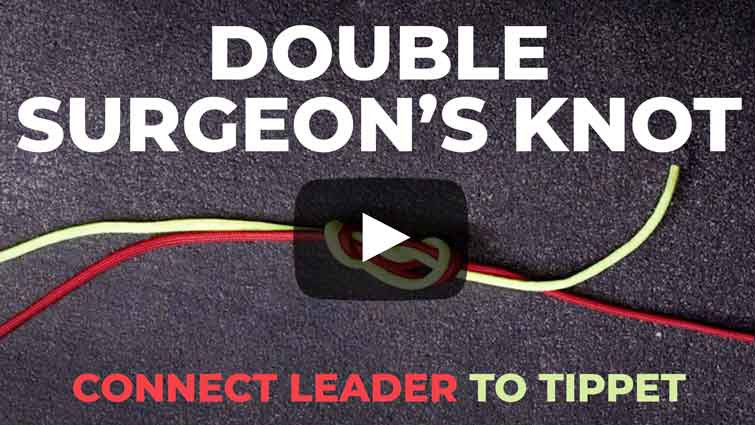 Double Surgeons Knot Fly Fishing Video
Double Surgeons Knot Fly Fishing Video
4.3 Understanding Material Properties
Monofilament is strong, flexible, and affordable, while fluorocarbon is nearly invisible in water and highly abrasion-resistant.
4.4 Selecting the Correct Tippet Size
Match the tippet size to the type of catch you’re looking for.
| Tippet Size | Diameter | Pounds Test | Fish Size |
|---|---|---|---|
| 03X | .015 inches | 25 pounds | Big Game |
| 02X | .013 inches | 20 pounds | Larger Salmon |
| 01X | .012 inches | 18.5 pounds | Striped Bass |
| 0X | .011 inches | 15.5 pounds | Salmon or Steelhead |
| 1X | .010 inches | 13.5 pounds | Bonefish |
| 2X | .009 inches | 11.5 pounds | Largemouth & Smallmouth Bass |
| 3X | .008 inches | 8.5 pounds | Bass & Larger Trout |
| 4X | .007 inches | 6 pounds | Average Trout |
| 5X | .006 inches | 4.75 pounds | Trout & Panfish |
| 6X | .005 inches | 3.5 pounds | Smaller Trout |
| 7X | .004 inches | 2.5 pounds | Smaller Trout & Panfish |
| 8X | .003 inches | 1.75 pounds | Small Flies |
Ensure the tippet size matches the fly you’re using to maintain sensitivity and improve your chances of landing fish.
5. Attaching the Fly: The Final Step
Attaching the fly securely is the final step in setting up your fly fishing rod.
5.1 Essential Knots for Fly Attachment
Two main knots are commonly used: the Improved Clinch Knot and the Non-Slip Loop Knot.
5.1.1 Improved Clinch Knot
Ideal for attaching the first fly on multiple nymph rigs and dry fly rigs.
5.1.2 Non-Slip Loop Knot
Used for tying on streamers where extra movement is needed, as well as on tailing droppers and emerges.
6. Mastering the Art of Reeling
Reeling is a critical aspect of fly fishing. Proper technique ensures you can control your line and set the hook effectively.
6.1 Techniques for Effective Reeling
Use an overhand or underhand grip. Ensure your drag isn’t too tight, keep your rod tip high to put pressure on the catch, and slowly reel in your line. If your catch is low in the water, reel in as much as you can, dip the end of your rod, and reel in again as you lift.
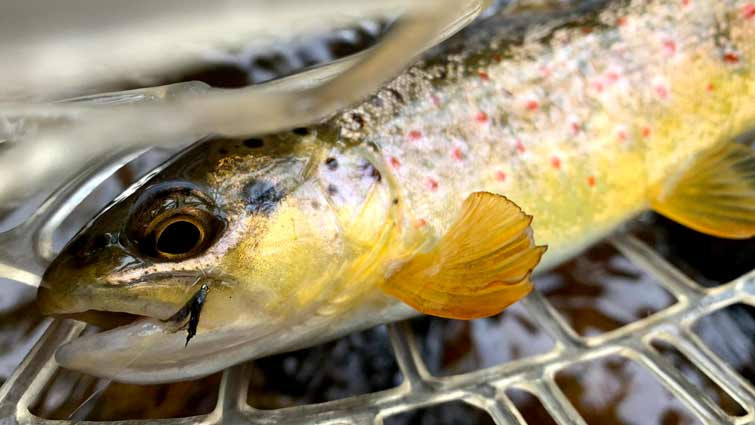 Small fly on tippet in mouth of small fish
Small fly on tippet in mouth of small fish
7. Frequently Asked Questions About Setting Up a Fly Fishing Rod
7.1 What is the ideal length for a beginner fly fishing rod?
A 9-foot rod is a great starting point for beginners, offering a balance of casting distance and control. According to the Federation of Fly Fishers, a 9-foot, 5-weight rod is versatile for various fishing situations.
7.2 How do I choose the right fly line weight for my rod?
The fly line weight should match the rod weight. This information is usually printed on the rod near the handle. Using the correct weight ensures optimal casting performance.
7.3 Can I use monofilament instead of fluorocarbon for my leader?
Yes, monofilament is a viable option, especially for beginners. It’s more affordable and easier to handle. However, fluorocarbon is less visible in water, which can be advantageous in clear water conditions.
7.4 How often should I change my tippet?
Change your tippet whenever you change your fly or if you notice any abrasion or damage. A fresh tippet ensures a strong connection and reduces the risk of losing a fish.
7.5 What is the purpose of the backing on a fly reel?
Backing provides extra line capacity when fighting larger fish. It sits underneath the fly line on the reel and is essential for landing fish that make long runs.
7.6 How do I know if my fly line is properly loaded on the reel?
The reel should be filled to about 1/8 inch from the edge of the spool. This allows for smooth casting and retrieval.
7.7 What are the best knots for fly fishing?
Essential knots include the arbor knot for attaching backing to the reel, the surgeons loop or Albright knot for connecting fly line to backing, the blood knot for attaching leader to fly line, the double surgeons knot for connecting tippet to leader, and the Improved Clinch Knot or Non-Slip Loop Knot for attaching the fly to the tippet.
7.8 How important is the drag system on a fly reel?
The drag system is crucial for fighting fish. It allows you to apply consistent pressure without breaking the line. A smooth drag system is essential for landing larger fish.
7.9 Can I use the same fly rod for both freshwater and saltwater fishing?
While some rods are versatile, it’s best to use a rod specifically designed for the environment. Saltwater rods are built to withstand corrosive conditions and often have more robust components.
7.10 Where can I find more information on fly fishing techniques and gear?
Flyermedia.net is your go-to source for comprehensive information on fly fishing. We offer detailed guides, reviews, and tips to help you master the sport.
8. Elevate Your Fly Fishing Experience with flyermedia.net
Setting up your first fly rod doesn’t have to be intimidating. By selecting the right materials and following these steps, you’ll be well on your way to enjoying the art of fly fishing. The key is to choose the materials that are right for your catch and conditions. With the right gear and a bit of practice, you’ll be casting like a pro in no time.
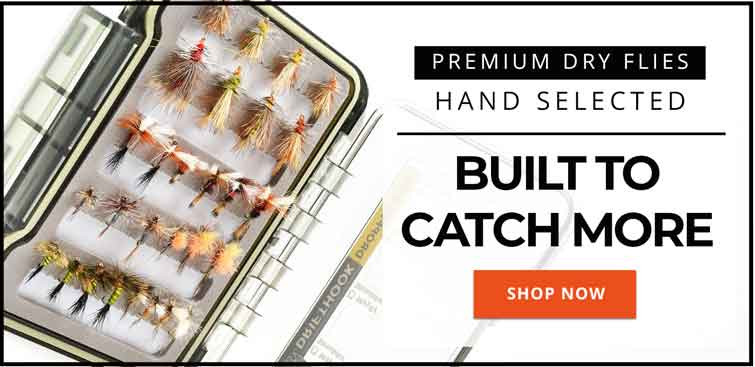 Fly Fishing Flies by Drifthook – Catch more on the water
Fly Fishing Flies by Drifthook – Catch more on the water
For even more detailed guidance and the latest insights into fly fishing, visit flyermedia.net. Discover a wealth of resources to enhance your skills and gear selection. Whether you’re looking for information on fly fishing training, the latest aviation news, or career opportunities, flyermedia.net has you covered.
Ready to take your fly fishing to the next level?
Visit flyermedia.net today to explore our comprehensive guides, expert tips, and the latest gear reviews. Don’t miss out on the opportunity to connect with a community of passionate anglers and aviation enthusiasts. Discover your potential with flyermedia.net and start your journey towards mastering the skies and the streams.
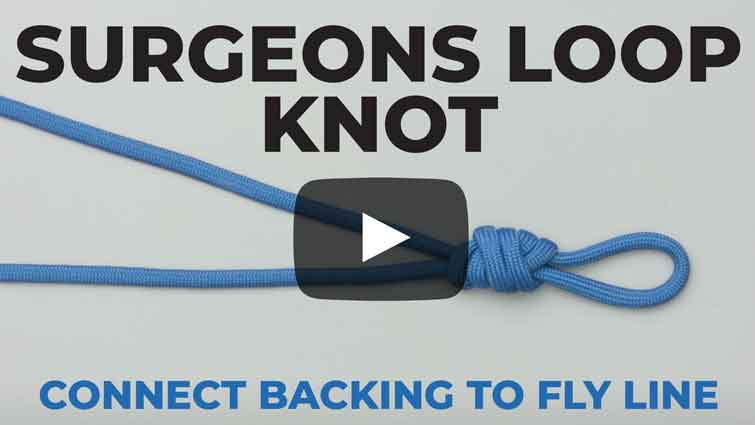 Surgeons Loop Knot – Video
Surgeons Loop Knot – Video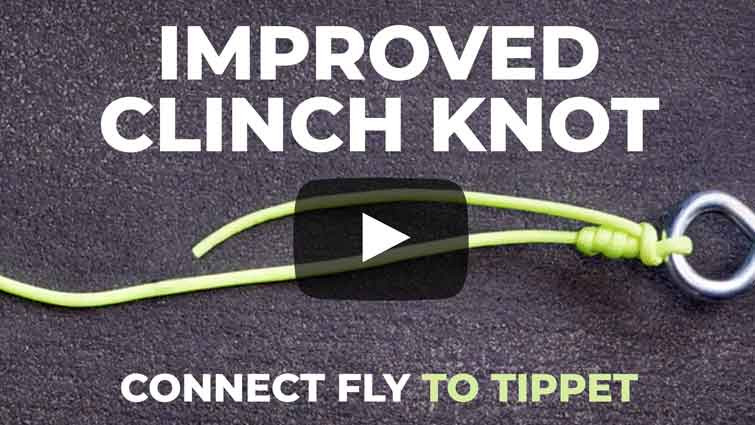 Improved Clinch Knot Video
Improved Clinch Knot Video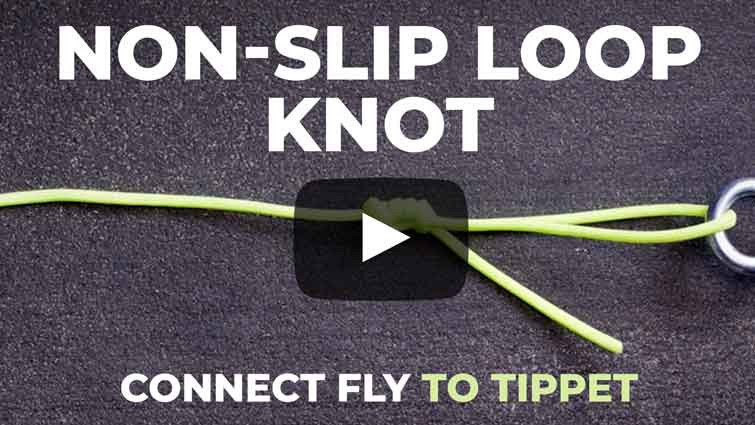 Non Slip Loop Knot Video
Non Slip Loop Knot Video